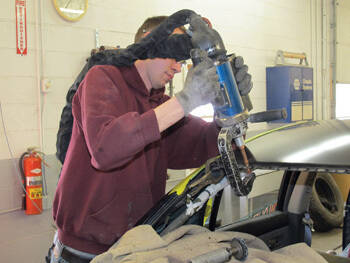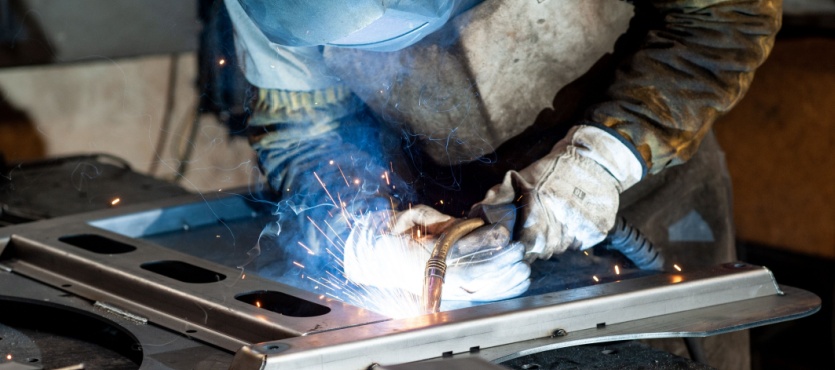All About Welding: Secret Insights Into Techniques and Best Practices for Success
Welding encompasses a range of methods, each suited for certain products and applications. Comprehending these techniques, such as GMAW, SMAW, and TIG, is crucial for achieving perfect outcomes. The ideal devices and safety and security practices can not be ignored. As preparation and repairing play critical roles in the welding procedure, understanding these components can substantially enhance the quality of the end product. What are the key aspects that assure an effective weld?
Recognizing Different Welding Methods
Welding strategies incorporate a variety of methods, each suited to particular applications and products. Amongst the most typical strategies are Gas Steel Arc Welding (GMAW), Protected Steel Arc Welding (SMAW), and Tungsten Inert Gas Welding (TIG) GMAW, likewise referred to as MIG welding, is prominent for its rate and flexibility, making it optimal for thin materials. SMAW, or stick welding, is favored for its simplicity and effectiveness in outdoor atmospheres, particularly with thicker metals. TIG welding uses precision and control, making it appropriate for elaborate work and non-ferrous steels (Montana Mobile Welding and Repair Belgrade Welding). Each technique has its unique advantages and considerations, permitting welders to choose the finest method based on the task's needs, material kind, and wanted outcomes. Comprehending these methods is necessary for effective welding
Vital Welding Tools and Tools
While numerous welding strategies need details abilities, the right tools and tools are similarly necessary for accomplishing top quality outcomes. Important welding tools includes welding machines, which vary depending on the method-- such as MIG, TIG, or stick welding. Protective gear, including helmets, aprons, and gloves, guarantees safety and comfort throughout the procedure. On top of that, fixtures and clamps aid protect products in position, making certain accuracy in welds. Consumables like welding rods, cord, and shielding gas are likewise essential elements that affect the top quality of the weld. In addition, tools such as cutters and mills assist in surface prep work and post-weld finishing, contributing to a specialist outcome. Purchasing high-grade equipment ultimately boosts the performance and effectiveness of welding jobs.
Security Practices in Welding
Correct safety and security practices are important in the welding industry to safeguard employees from possible risks. Welders need to put on appropriate individual safety devices (PPE), consisting of helmets with appropriate shading, gloves, and flame-resistant garments. Sufficient ventilation is important to decrease exposure to dangerous fumes and gases generated throughout the welding process. Additionally, workers ought to be learnt the proper handling of welding devices to prevent accidents. Fire safety and security measures, such as keeping combustible products far from the welding area and having fire extinguishers readily available, are needed. Routine assessments of tools and offices can aid recognize prospective risks prior to they lead to mishaps. By sticking to these safety and security techniques, welders can develop a safer working setting and lessen dangers related to their trade.
Preparing Products for Welding
Preparing materials for welding is a vital step that substantially influences the quality and integrity of the end product (Belgrade). Appropriate preparation includes cleansing the surfaces to eliminate contaminants such as oil, corrosion, and dirt, which can jeopardize the weld. Methods such as grinding, sanding, or utilizing solvents are typically utilized to attain a clean surface area. In addition, ensuring that the materials mesh snugly is crucial; spaces can bring about weak welds. It's welding gate also important to take into account the positioning and positioning of the parts, as this will certainly influence the ease of welding and the last outcome. Lastly, selecting the proper filler material and making sure compatibility with the base steels is vital for achieving strong, resilient welds
Tips for Achieving High-Quality Welds
Attaining premium welds needs focus to detail and adherence to ideal practices throughout the welding procedure. Appropriate joint preparation is crucial, ensuring surfaces are totally free and tidy from pollutants. Selecting the suitable filler product and welding technique based on the base metals is critical for optimal bonding. Preserving regular travel speed and angle while welding can advertise and protect against problems uniformity. Additionally, regulating warmth input is essential; extreme warm can lead to warping and deteriorated joints. If needed, routinely inspecting the welds during the process permits for immediate adjustments. Using appropriate post-weld therapies, such as cleaning and tension relief, can enhance the sturdiness and stability of the weld, eventually making certain a successful result.
Repairing Common Welding Issues
Welding usually provides difficulties that can influence the high quality and integrity of the final product. Common problems such as porosity, irregular weld grains, and overheating can occur, each calling for particular troubleshooting methods. Understanding these troubles is essential for welders to boost their abilities and accomplish excellent results.
Porosity Problems Described
Porosity can often be neglected, it remains a crucial problem in welding that can jeopardize the stability of a finished product. Porosity refers to the visibility of tiny gas pockets within the weld bead, which can lead and weaken the joint to premature failure. This trouble normally emerges from impurities, wetness, or incorrect securing gas insurance coverage during the welding procedure. To reduce porosity, welders need to verify that the base products are completely dry and clean, utilize suitable protecting gases, and maintain consistent welding specifications. On a regular basis checking the devices and setting can likewise assist determine prospective concerns before they manifest in the weld. Addressing porosity effectively is vital for accomplishing strong, resilient welds that meet high quality criteria.

Inconsistent Weld Beans
Inconsistent weld grains can considerably influence the quality and strength of a completed product. Various aspects contribute to this problem, including incorrect traveling rate, inaccurate amperage settings, and irregular electrode angles. When the welder relocates too swiftly, a bead might show up slim and do not have infiltration, while moving as well slowly can cause extreme buildup. Additionally, making use of the wrong amperage can result in why not find out more either undercutting or too much spatter, both of which concession weld stability. The welder's method, such as inconsistent lantern motion, can also cause irregular bead appearance. To mitigate these problems, welders should focus on keeping steady, controlled motions and making sure proper tools setups to accomplish harmony in their welds. Consistency is essential to achieving strong and trusted welds.
Overheating and Warping Issues
Extreme warmth throughout the welding process can lead to considerable getting too hot and deforming problems, affecting the architectural stability of the work surface. These issues commonly materialize as distortion, which can endanger alignment and fit-up, making further assembly challenging. Elements adding to overheating consist of the choice of welding parameters, such as voltage and take a trip rate, along with the kind of product being welded. To mitigate these issues, welders must keep consistent traveling speed and suitable warmth input while checking the workpiece temperature level. In addition, pre-heating or post-weld warm treatment can assist minimize stress and anxieties caused by fast air conditioning - Fabrication. Regular inspection and adherence to ideal practices are necessary in alumaloy protecting against overheating and making certain the durability and dependability of welded frameworks
Frequently Asked Questions
What Are the Job Opportunities in the Welding Industry?
The welding industry uses diverse job chances, consisting of placements as welders, designers, inspectors, and educators. Specialists can work in manufacturing, building, aerospace, and auto fields, taking advantage of solid demand and affordable incomes in different functions.
Exactly How Can I Enhance My Welding Speed Without Giving Up Quality?
To boost welding rate without sacrificing high quality, one ought to exercise efficient methods, preserve tools, optimize settings, and enhance hand-eye coordination. Normal training and looking for responses can additionally considerably add to accomplishing faster, top quality welds.
What Certifications Are Offered for Welders?
Various certifications exist for welders, consisting of those from the American Welding Society (AWS), the National Facility for Construction Education and Research Study (NCCER), and various industry-specific companies. These qualifications boost employability and demonstrate skill proficiency.
How Does Welding Impact the Qualities of Metals?
Welding affects the buildings of steels by modifying their microstructure, which can bring about modifications in strength, ductility, and solidity. Warmth input and cooling prices during the procedure significantly impact these material attributes.
Can I Weld Dissimilar Metals With Each Other?
